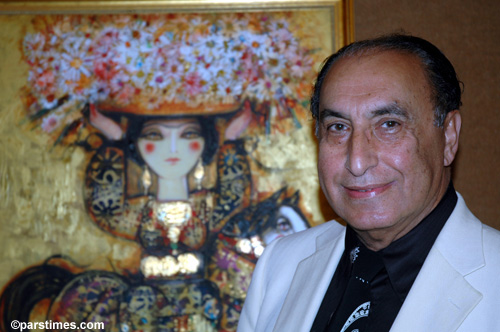A World Known Artist
Founder of the Persian School of Surrealism in Painting
Ovissi is born in 1934, one of the living legends of Contemporary Iranian art, initiating the modern art movement in the 1960s in Iran and has continued to be an inspiration in the field. With exhibitions spanning across the globe from Brazil to Japan, Europe and the United States. Ovissi has firmly established himself as a brilliant and versatile international artist whose passionate work presents a unique blend of European, Persian and contemporary art. A painter, sculptor, engraver, designer and goldsmith, he has published over seventeen books in Italian, Japanese, French, Spanish, Persian and English, and is the recipient of numerous international awards and prizes. Starting in 2007, Ovissi’s works have been selling at record prices in international art auctions. His works continue to pull in record prices and demand for his work has been rising in the last five years.
Ovissi has been honored to receive the First Prize award at the Tehran Biennale in 1957, Grand Prize at the International Art Exhibition in Monaco in 1974 and Gold Medal in Venice Biennale in 1979. Ovissi has partipated in three Biennale: Tehran, Venice & Sao Paolo.
Dr. Richard Ettinghausen, head of the Islamic Art Section of the Metropolitan Museum, gave this opinion on Ovissi for his exhibition at the Museum Columbia University in 1992: “Ovissi’s works count among the best modern paintings, but at the same time they reflect Persian art…..Ovissi has a message for both the East and the West.”
His work is part of major museum collections such as the National Gallery of Athens, the New York University Art Museum, the Fine Art Museum of North Carolina, the Contemporary Art Museum of Madrid, and the National Museum of Oriental Art in Rome, and is included in over 300 private collections worldwide. Nasser Ovissi has over a dozen books published and is also featured in E. Benezit’s “Dictionaire des Peintures, Sculpteurs, Dessinatrurs et Graveurs” Vol. 9, Librurie Grand, Paris.
Ovissi is famous for his symbols of the horse, the beautiful mysterious woman and pomegranates. He has found a language on his canvas that blends the rich history of Persian art and the emotive, color-driven strokes of contemporary art. One of the horses he painted in 1964 has been copied by UNICEF 5 million times for a benefit for the childeren’s fund. It was a green horse.
Ovissi has been painting and exhibiting successfully since the 1970s. Starting in 2001, Ovissi’s works have been selling at record prices in international art auctions. His work has been considered as one of the best investment tool among art lovers and investors. Ovissi’s works have been sold in different international art auctions (see below for listing). Each year, there are more demands for his original works and every piece has been sold with higher price tag from previous years.
“Ovissi is an artist who is fond of the traditional culture of his country. His works are not a mere expression of the mythology and folklore of Iran captured in the atmosphere of the one thousand and one nights but from the artistic viewpoint he has strong expression and the personal symbols and images prevalent in his works distinguish his works from others. The symbols and effects of Ovissi’s works are not objective but are saturated with the fantastic memories, furthermore, on a whole he has a poetical concept expressed in lines and colors. Symbols and effects in Ovissi’s works are of a quality that resembles his work to a beautiful piece of calligraphy”.
Wolds Encyclopedia of Modern Paintings, vol, IV, 1970, Milan, Italy
“Persian inspiration and Western techniques are constantly combined in Ovissi’s work: oriental leitmotifs are interlaced using pure or mixed mediums; ladies, lovers, historical figures on horseback or playing the lute, surrounded by flowers, come to life in controlled balance, in lithographies, etchings, or glodwork. Subjects painted in series, such as the bullfights already referred to lovers- the series inspired by the Rubaiyyat of Omar Khayyam which the lithographist Olmos considers to be one of the etching masterpieces of the 20th century- and those strange to tributes to the great painters Velazquez, El Greco and de la Tour”.
De Sauvage, Art Critic, Montreal.
“His color has magic and charm”. Carlos Arean, Directo of the contemporary art museum, Madrid, 1980
Nasser Ovissi transmutes Persian calligraphy into an incandescent explosion of absolute spiritual joy”. Nanccy Berq; Robert Fullerton Art Museum; California State University, San Bernardino

